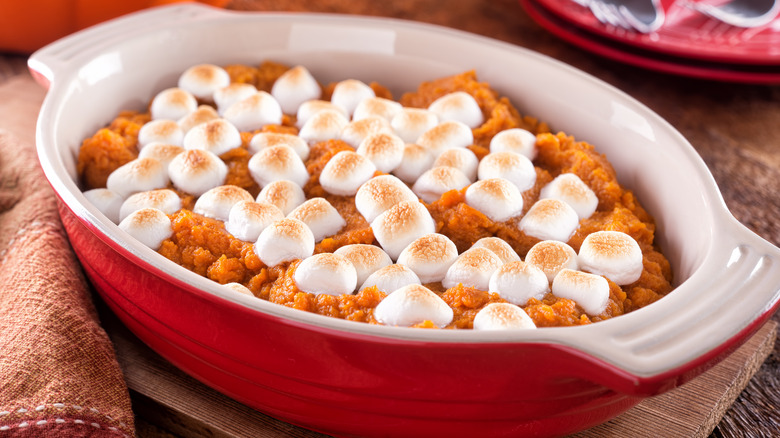This Could Be Why Your Sweet Potato Casserole Is So Dense
What are your family's favorite Thanksgiving dishes? On this special fall holiday, there are so many classics to choose from, from juicy roast turkey to buttery stuffing to indulgent green bean casserole. Or maybe mashed potatoes and gravy round out your holiday spread before the parade of desserts, which range from pumpkin to apple to sweet potato pies.
And if your family is really into sweet potatoes, it's likely that the sweet, starchy tubers pull double duty on the holiday, showing up, too, in their classic side dish form: sweet potato casserole, a dish full of sweet potatoes that are often mixed with other rich ingredients, including heavy cream, butter, and brown sugar, or the Thanksgiving version many of us know that features an uber-sweet layer of browned marshmallows (via Smithsonian). And although most of us would only think to make sweet potato casserole as part of a holiday spread, it's actually a great side dish at any time of the year — sans the marshmallows, perhaps.
If you're itching to make one soon, just take care not to mix up a casserole that's too dense.
Keep that casserole light and fluffy by adding egg
If you love sweet potato casserole enough to want to bake some up outside of the months of November and December, be sure you have your technique down before stepping into the kitchen. All too often, according to Eating Well, sweet potato casserole turns out heavy and dense where it should be light and fluffy. What's most often the culprit for leaden casserole? Not adding an egg, according to the outlet.
Eggs help lighten the heavy filling of a sweet potato casserole, allowing it to puff in the oven (like a soufflé) and helping it to maintain that height, resulting in a casserole with a pleasingly fluffy texture. Once you've found your ideal egg-containing sweet potato casserole recipe and whipped it up, just do a quick temperature check before removing the casserole from the oven: Eating Well notes that egg-containing fillings should reach an internal temperature of 165 degrees Fahrenheit.

